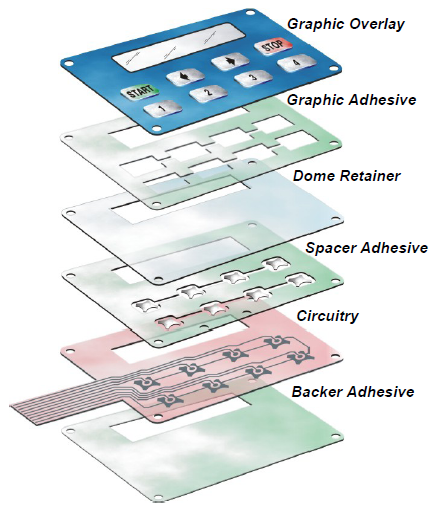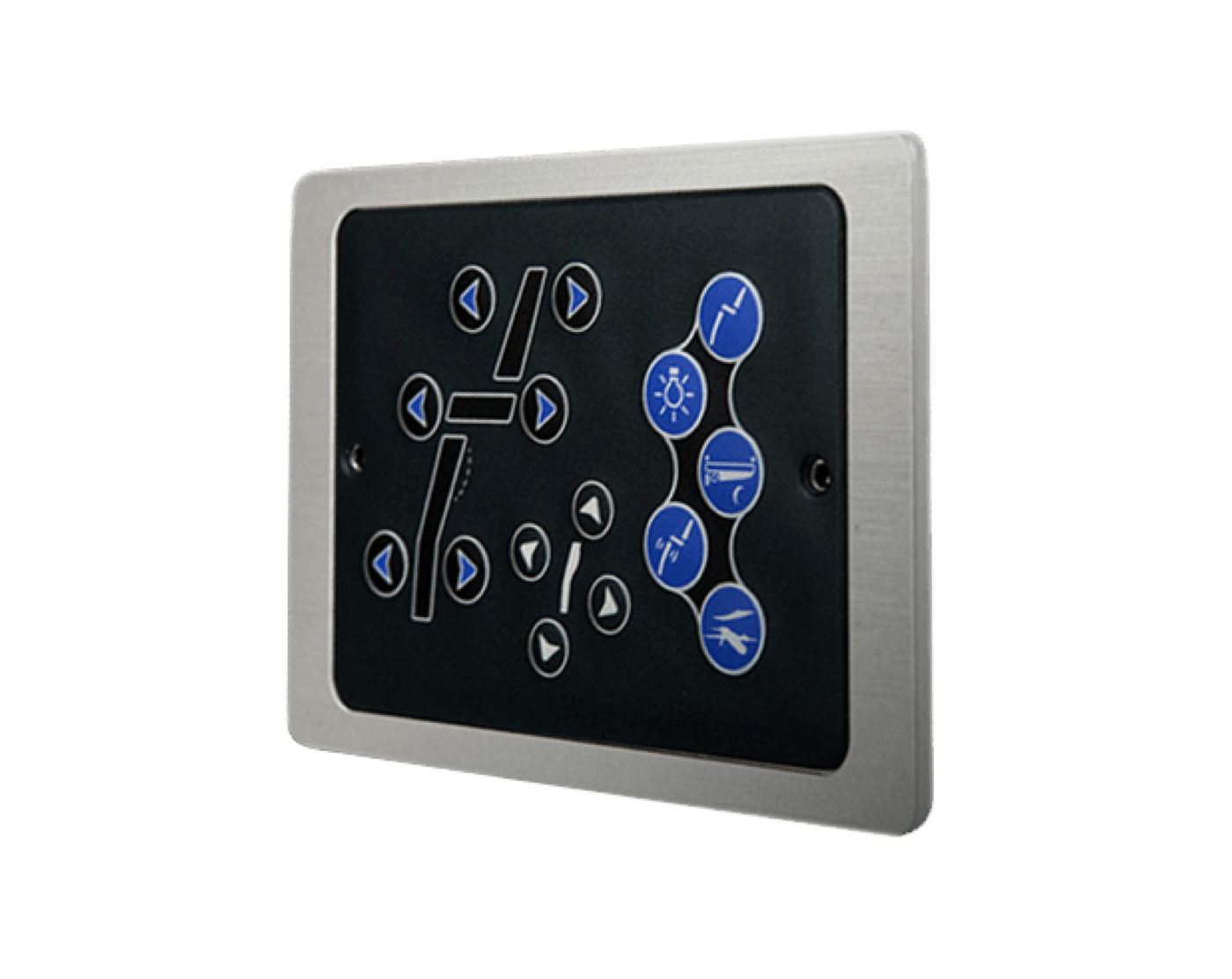Membrane Switch Technology: The Key to Reputable and Economical Interfaces
Membrane button innovation has actually emerged as a pivotal part in the design of customer interfaces, supplying both reliability and cost-effectiveness across a diverse variety of applications. As we check out the multifaceted benefits of membrane layer switches, their potential for development elevates concerns regarding future applications and progressing fads.
Recognizing Membrane Layer Switch Over Modern Technology
Membrane switch technology is a commonly made use of interface solution in various digital gadgets, providing a smooth blend of performance and layout. This technology incorporates numerous layers of products, usually including a visuals overlay, spacer layer, and a circuit layer. The visuals overlay displays the interface elements, while the spacer layer divides the circuit layer from the overlay till a customer turns on a switch.
When stress is put on the overlay, the circuit layer finishes the electric circuit, sending a signal to the device. This mechanism enables different arrangements, including tactile comments and backlighting choices, improving customer interaction. Membrane buttons are generally manufactured using durable products such as polyester or polycarbonate, guaranteeing durability and resistance to environmental variables like dampness and dust.
The adaptability of membrane layer switches over allows their application in varied sectors, consisting of medical devices, customer electronic devices, and commercial controls. Their compact design enables integration into space-constrained environments, giving an efficient user interface without jeopardizing aesthetic allure. Recognizing the intricacies of membrane layer button innovation is essential for manufacturers and developers seeking to produce trustworthy and effective human-machine interfaces.
Trick Benefits of Membrane Switches
While various user interface services exist, membrane changes deal unique benefits that make them a recommended choice in various applications. Among the key benefits is their resilience; membrane switches are created to withstand extreme ecological conditions, including wetness, dust, and temperature variations, guaranteeing lasting efficiency. This resilience significantly lowers the requirement for regular replacements, thus decreasing general maintenance expenses.

Moreover, membrane layer buttons are lightweight and small, making them ideal for applications where area is restricted. Their inconspicuous style contributes to a sleek look without endangering performance.
Cost-effectiveness is likewise a notable advantage, as the production procedure for membrane layer changes tends to be cheaper compared to standard mechanical switches. This cost, combined with their integrity and simplicity of installation, positions membrane switches over as a functional option for a wide variety of sectors seeking efficient and effective interface.
Applications Across Various Industries
Just how do membrane switches adjust to the diverse demands of different sectors? Membrane button technology is progressively recognized for its versatility, making it suitable for a vast array of applications throughout several fields. In the clinical field, membrane buttons are used in analysis tools and individual surveillance devices, where their sturdiness and simplicity of cleaning are important for keeping hygiene requirements. The automotive industry uses these switches in dashboards and control board, offering a streamlined aesthetic while ensuring great site easy to use operation.
In customer electronics, membrane switches provide a compact option for push-button controls and home appliances, improving individual experience with intuitive design. In addition, the industrial sector leverages membrane layer buttons for machinery control board, taking advantage of their resistance to extreme settings, such as moisture and dust.
Army and aerospace applications also make use of membrane layer buttons for their reliability and capability to hold up against extreme problems, making certain operational efficiency in essential situations. The food and drink industry takes on these switches for automated systems, where hygiene and ease of procedure are extremely important (membrane switch). Eventually, membrane layer switches are customized to fulfill the distinct demands of each market, confirming their important role in contemporary technology interfaces
Design and Customization Choices

In the world of membrane layer button technology, layout and personalization alternatives play a pivotal duty in enhancing performance and user communication. These switches can be customized to satisfy specific operational requirements and check my site aesthetic choices, making them flexible elements in various applications.
Among the key customization alternatives is the format of visite site the switch itself, which can be designed to accommodate one-of-a-kind customer interfaces and ergonomic factors to consider. By changing the shape, size, and arrangement of switches, suppliers can produce user-friendly designs that promote simplicity of usage. Furthermore, the incorporation of various colors and graphic overlays permits for branding and enhanced visibility, guaranteeing that users can promptly determine functions.
In addition, membrane buttons can be engineered with various responsive feedback devices, such as raised switches or audible clicks, to boost the individual experience. Various products can also be chosen for toughness and environmental resistance, resolving elements such as dampness, temperature fluctuations, and chemical exposure.
Inevitably, the substantial design and customization alternatives available in membrane layer button innovation encourage businesses to develop tailored services that not just meet practical needs yet likewise straighten with their branding and operational requirements.

Future Trends in Membrane Layer Buttons
As membrane layer switch innovation remains to advance, future trends are increasingly focused on boosting user experience and integrating sophisticated performances. One substantial fad is the integration of touch-sensitive and capacitive innovations right into conventional membrane switches. This growth enables more intuitive interface, providing tactile comments while preserving a smooth style.
One more emerging trend is the use of eco-friendly materials, driven by the expanding need for lasting production techniques. Suppliers are seeking to lower their carbon impact by making use of recyclable substratums and low-impact inks, lining up with worldwide sustainability goals.
Furthermore, the rise of the Web of Things (IoT) is prompting the incorporation of smart attributes right into membrane switches. Enhanced connectivity alternatives will certainly allow devices to communicate with each various other, permitting seamless integration right into more comprehensive systems.
Furthermore, developments in printing technologies, such as electronic printing, are enabling higher layout versatility and customization. This enables suppliers to create intricate layouts and lively colors cost-effectively.

Verdict
Finally, membrane button technology stands for an important innovation in customer interface design, supplying considerable benefits in sturdiness, customization, and cost-effectiveness. Its extensive applicability across diverse markets emphasizes its significance in modern-day technology. As improvements continue to emerge, particularly in touch-sensitive user interfaces and sustainable materials, the possibility for membrane changes to boost user experience and performance stays encouraging. Continued exploration of this modern technology will likely yield additionally renovations and broaden its range in future applications.